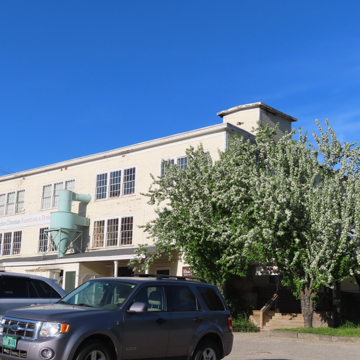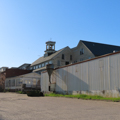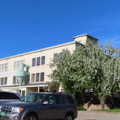This mill, now a shopping and craft center, is Vermont's oldest remaining nineteenth-century wood-frame woolen mill building and the best example of a type that formed the nucleus of dozens of villages throughout the state. The first dam and grist-and sawmills here on the Ottauquechee River were built by Richard Southgate in 1786. His grandson, B. F. Southgate, built a cotton mill on the present site in 1828, which operated until 1835 and burned in 1852. The four-story central portion of the present mill dates from the rebuilding that year. It employed 150 workers and operated as a woolen mill, under various names, until 1973. Vermont Native Industries, which ran the mill for most of the twentieth century, built a striking Tudor Revival product showroom across from the mill in 1925. The impact of early-twentieth-century revival styles was light in Vermont, and the two-story tri-gable form, steep gables with false timbering, and casement windows make this one of the best examples in the state.
At the height of Vermont's wool-raising boom (1824–1848), federal tariffs made local wool and locally manufactured clothing competitive with English imports. Large woolen mills, and many cotton factories, were built throughout Vermont, especially in Windham and Windsor counties. In addition to Bridgewater, there were large mills in Saxtons River, Bellows Falls, Springfield, Ludlow, Cambridgeport, Windsor, Woodstock, Bethel, and elsewhere. After the tariffs ended, most mills went in and out of production repeatedly, although many profited from producing woolens during the Civil War. Only a few survived the 1870s depression, but those that did remained major local employers well into the twentieth century. The Gay Brothers woolen mill (1834, 1865) in the center of Ludlow village is perhaps the next best remaining example, with a brick exterior and a distinctive five-story stair and clock tower. Today, pedestrian galleries across its most visible walls obscure its historic form.









